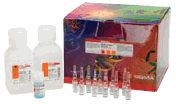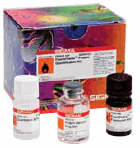Tools for Protein Quantitation
Trusted Products for Protein Assays
Reliable products for traditional protein quantitation techniques such as BCA and Bradford as well as products for alternative total protein determination assays such as Lowry and Micro Pyrogallol.
Colorimetric Assays
BCA Assay
Protein determination is one of the most common operations performed in biochemical research. The principle of the bicinchoninic acid (BCA) assay is similar to the Lowry procedure, in that both rely on the formation of a Cu2+-protein complex under alkaline conditions, followed by reduction of the Cu2+ to Cu1+. The amount of reduction is proportional to the protein present. It has been shown that cysteine, cystine, tryptophan, tyrosine, and the peptide bond are able to reduce Cu2+ to Cu1+. BCA forms a purple-blue complex with Cu1+ in alkaline environments, thus providing a basis to monitor the reduction of alkaline Cu2+ by proteins.
The BCA assay is more sensitive and applicable than either biuret or Lowry procedures. In addition, it has less variability than the Bradford assay. The BCA assay has many advantages over other protein determination techniques:
- The color complex is stable
- There is less susceptibility to detergents
- It is applicable over a broad range of protein concentrations

Bicinchoninic Acid Kit for Protein Determination, BCA
200-1000 µg/ml protein
Proteins reduce alkaline Cu(II) to Cu(I) in a concentration-dependent manner. Bicinchoninic acid is a highly specific chromogenic reagent for Cu(I), forming a purple complex with an absorbance maximum at 562 nm. The absorbance is directly proportional to protein concentration. This is an alternative to the Folin-Ciocalteu reagent for protein determination.
Components:
- Bicinchoninic Acid Solution
- 4%(w/v) CuSO4
- 5H2O Solution
- BSA Protein Standard
Ordering Information

QuantiPro™ BCA Assay Kit, QPBCA
0.5-30 µg/ml protein
Can be used to measure very dilute protein concentrations in very small sample volumes. Accurately measures protein concentrations from 0.5 to 30 µg/ml in tube assays and 1 to 20 µg/ml in 96 or 384 well plate assays.
Components:
- Quantipro buffer QA
- Quantipro buffer QB
- BSA Protein Standard Solution
- 4% Copper(II) sulfate pentahydrate solution
Ordering Information

Bradford Assay
The Bradford Reagent, B6916 can be used to determine the concentration of proteins in solution. The procedure is based on the formation of a complex between the dye, Brilliant Blue G, and proteins in solution. The protein-dye complex causes a shift in the absorption maximum of the dye from 465 to 595 nm. The amount of absorption is proportional to the protein present. The Bradford Reagent requires no dilution and is suitable for micro, multiwell plate, and standard assays. The linear concentration range is 0.1-1.4 mg/mL of protein, using BSA (bovine serum albumin) as the standard protein.
The Bradford Reagent is compatible with reducing agents, which are often used to stabilize proteins in solution. Other protein assay procedures (Lowry and BCA) are not compatible with reducing agents. The Bradford Reagent should be used in place of these protein assays if reducing agents are present. However, the Bradford Reagent is only compatible with low concentrations of detergents. If the protein sample to be assayed has detergents present in the buffer, it is suggested to use the BCA protein determination procedure.
Bradford Reagent, B6916
This protein assay is based on complexing of proteins with Brilliant Blue G. The protein sample is mixed with the reagent and then read at 595 nm after a short incubation at room temperature.
Features and Benefits:
- The reagent is ready to use. No mixing or dilution required
- Color development is rapid. Only a five minute incubation and then the sample is read at 595 nm
- Reducing sugars and reducing substances along with thiols do not interfere with this reagent
- Reagent is suitable for micro (1-10 μg/ml) and standard (50-1400 μg/ml) assays
- Can be used in microwell plate assays
Ordering Information

Lowry Assay
The Lowry Assay, L3540 is a common method for quantitation of soluble protein. Due to its sensitivity, simplicity, and precision, it is often a method of choice. Based on two chemical reactions the first in which alkaline cupric tartrate complexes with the peptide bond of the protein and the second a reduction with Folin and Ciocalteu's reagent, F9252. This reaction yields a purple color in which the absorption is read between 500 and 800 nm. This assay may be performed directly with a protein solution, or a precipitation method involving DOC and TCA may be used. Precipitation eliminates interference often caused by other reagents such as Tris, ammonium sulfate, EDTA, sucrose, citrate, and others. Protein concentration can then be determined using a calibration curve.
Total Protein Kit, Micro Lowry, Peterson's Modification, TP0300
The Total Protein Kit, Micro Lowry is based on Peterson's modification of the micro Lowry method and utilizes sodium dodecylsulfate, included in the Lowry Reagent, to facilitate the dissolution of relatively insoluble lipoproteins.1
Components:
- Lowry Reagent, Powder
- 0.15% Deoxycholate (DOC) Solution
- Trichloroacetic Acid (TCA) Solution
- Folin and Ciocalteu's Phenol Reagent
- BSA Standard, 2 mg
Reference
Ordering Information

Micro Pyrogallol Red Method
The micro pyrogallol red procedure is a modification of a published method.1 The method is based on measuring the shift in the absorption that occurs when the pyrogallol red molybdate complex binds to basic amino acid groups of protein molecules. The increase in absorbance at 600 nm is directly proportional to protein concentration in the sample. This method displays a linear range from 0.01-2.0 mg/mL.
Total Protein Kit, Micro Pyrogallol Red Method, TP0400
The Micro Pyrogallol Red Kit contains reagents sufficient for 240 assays. The kit includes two 120 ml bottles of Total Protein Reagent, T2074 and 5 ml of Protein Standard Solution.
Components:
- Total Protein Reagent
- Protein Standard Solution; Human Serum Albumin
Reference
Ordering Information
To continue reading please sign in or create an account.
Don't Have An Account?